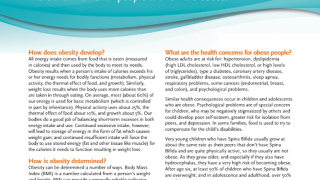Adequate treatment of pre-diabetes and diabetes can add years to the lives of people with Spina Bifida.
Type 2 diabetes is the most common type of diabetes, and the most preventable. Also called adult onset or non-insulin dependent diabetes, it is a chronic condition that affects how the body uses insulin to metabolize glucose (sugar)—the body’s main source of fuel. People who have type 2 diabetes either do not produce enough insulin, or, as a consequence of the metabolic changes resulting from being overweight or obese, their body resists the effects of the insulin. This problem often comes on slowly, and may initially appear as “pre-diabetes,” also called metabolic syndrome.
Pre-diabetes is a condition that serves as a warning sign that a person is at risk for developing type 2 diabetes. Once a person’s body increases its resistance to insulin, their insulin simply will not work as it should, resulting in elevated blood sugars and spilling of glucose in urine.
This information sheet covers:
- How pre-diabetes becomes type 2 diabetes, and how it affects the body
- Common risk factors associated with type 2 diabetes
- The principal causes of type 2 diabetes and why people with Spina Bifida are more vulnerable to developing it
- How pre-diabetes and type 2 diabetes are evaluated
- The role of lifestyle and medicine in prevention and treatment of type 2 diabetes
This information does not constitute medical advice for any individual. As special cases may vary from the general information presented here, SBA advises readers to consult a qualified medical or other professional on an individual basis.
Tags



